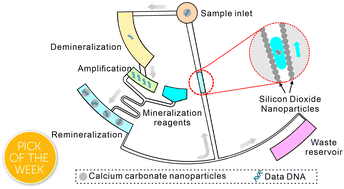A nanoparticle-coated microfluidic chip for automated, non-destructive extraction of encapsulated DNA in data storage†
Abstract
DNA data storage based on tubes as physical storage carriers has been developed to solve the problem of the exponential growth of information. Compact disk (CD)-microfluidics that employs centrifugal forces for fluidic manipulation offers an attractive alternative that integrates complex assays onto a miniaturized platform to result in automation for DNA data storage. In this work, we develop a CD microfluidic chip modified with nanoparticles for accurate fluid flow control. The nanoparticle coating turns microchannels into valves or pumps, which reduces the error in fluidic control from 62% to 6%. Based on the nanoparticle coating, the chip integrates demineralization, nucleic acid amplification, and re-mineralization functions for automated, non-destructive information extraction. We prove the functionality of the chip with mineralized DNA data. Compared to purely manual operation and traditional amplification techniques, the microfluidic chip saves human power and time consumption, demonstrating an essential contribution to the development of DNA data storage.

- This article is part of the themed collections: Imaging, biosensing and diagnostics: 2025 Chemical Science symposium collection, 2023 Chemical Science HOT Article Collection and 2023 ChemSci Pick of the Week Collection


 Please wait while we load your content...
Please wait while we load your content...